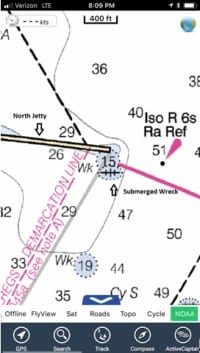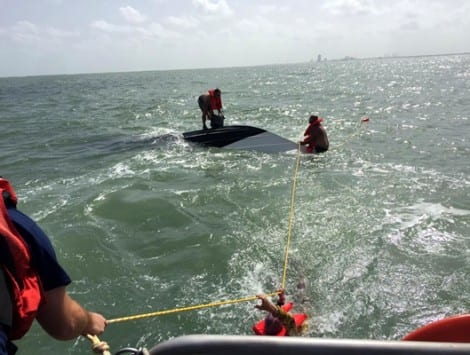 By Bob Currie, Vessel Examiner
By Bob Currie, Vessel Examiner
United States Coast Guard Auxiliary Flotilla 081-06-08
Sometimes things happen that are beyond your control. This is such a story. It happened last week and involved 3 men aboard a recreational fishing vessel fishing near the North Jetty limit. Here is what happened.
Flotilla 081-06-08 is based at Coast Guard Station Galveston. The Coast Guard Auxiliary is the uniformed civilian component of the US Coast Guard and supports the Coast Guard in nearly all mission areas. The Auxiliary was created by Congress in 1939. For more information, please visit www.cgaux.org.
The Boat and Crew
The boat was a 31 foot fishing boat with three experienced fishermen aboard. The boat was powered by twin outboard 225 HP engines. The crew members were familiar with the area in which they were fishing. They had been fishing near an old sunken dredge due south of the north marker of the North Jetty (see chart representation below).
The Sinking of the Boat
When the crew were finished fishing near the end of the jetty, the captain came out on the throttles and the boat at first started forward. But something went terribly wrong.  The bow nosed up and the boat was sucked backwards and the transom was pulled below the surface, immediately flooding the boat.
The bow nosed up and the boat was sucked backwards and the transom was pulled below the surface, immediately flooding the boat.
It was later determined that an old anchor line had become fouled in both propellers. As the propellers wound the anchor line around them, the stern of the boat was pulled below the surface and water filled the boat quickly. Before the boat sank completely and capsized, one of the crew managed to call the US Coast Guard on their VHF marine radio and announce a mayday emergency.
The radio operator was able to tell the Coast Guard Watchstander their location, and a 45-foot rapid response boat was dispatched to the scene. The captain of the boat also set his anchor as soon as he realized he was in trouble. The boat was close to the shipping lane, and a wave from a passing tanker was the final straw that capsized the boat. The captain said that setting the anchor helped hold an air pocket in the bow of the boat and kept it from sinking completely.
The Rescue
When the Coast Guard rapid response boat arrived at the scene, they found the boat capsized and three men in life jackets clinging to the hull. The crew of the rapid response boat tossed a line to the men clinging to the capsized hull, and one man attached the line to the bow winch ring. The three men then pulled themselves aboard the rapid response boat hand over hand (photo courtesy of Coast Guard Station Galveston).

What Went Right to Make a Happy Ending
Although this could have happened to anyone, the outcome could have been much worse. Several things came together to help make this a successful rescue. First, the boat was equipped with proper personal flotation devices (life jackets) for everyone on board. Second, there was a VHF marine radio aboard and someone who knew how to use it. Third, there was a 45-foot US Coast Guard rapid response boat and crew who responded quickly to the mayday call. Fourth, the crew stayed together with their capsized boat and waited for help. Finally, by setting the anchor the boat didn’t drift into the active shipping lane, and also the anchor line helped keep the boat afloat by holding the bow in a position that trapped air in the bow. Things often don’t go well when persons abandon their overturned boat and try to swim to shore (or in this case, to the jetty). The boat crew did everything right in this case. They were prepared for an emergency, and they executed their part well.
Aftermath
No, the boat is not sitting on the bottom of the Gulf of Mexico where it sank. Instead, a local sea towing company responded immediately, and was able to right the capsized boat, pump the water out, and tow it to a marina for repairs. The lessons are clear here:
- Have life jackets for every person aboard and wear them.
- Have a VHF marine radio aboard and know how to use it.
- Keep a cool head when an emergency does happen, and stay with the boat if it capsizes.
- Set your anchor whenever you become disabled.
- Subscribe to a towing service.
For more information on boating safety, please visit the Official Website of the U.S. Coast Guard’s Boating Safety Division at www.uscgboating.org. Questions about the US Coast Guard Auxiliary or our free Vessel Safety Check program may be directed to me at [email protected]. I am available to perform free Vessel Safety Checks, and I will come to your location to perform them. SAFE BOATING!
[8-20-2018]

 Posted in
Posted in 
























